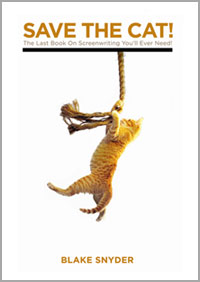

Featured Book of the Month
Blake Snyder has bravely subtitled his book, "The Last Book on
Screenwriting You'll Ever Need." But as they say, "it ain't
braggin' if you can back it up."
If, like most wannabe screenwriters, you've already purchased screenwriting books by the shelf-full, Snyder's might indeed be the last book you'll ever need. If you are new to screenwriting, you could do a lot worse than to make this the first book that you buy.
Unlike most "how-to" books, "Save the Cat" goes beyond the "how's" and gets to the "why's." Embedded in the "why's" are some very powerful secrets of great storytelling. More important, also embedded are the secrets to getting scripts sold.
The book's main tools and techniques are as follows:
* The four elements of every winning logline
* The seven immutable laws of screenplay physics
* The ten genres that every movie ever made can be catagorized by - and why they're important to your script
* Why your Hero must serve your idea
* Mastering the Beats (Blake Snyders fifteen beats to a perfect structure)
* Creating the "Perfect Beast" by using...The Board
* How to get back on track with proven rules for script repair
Save the Cat's main thrust is to introduce you to the "Blake Snyder Beat Sheet" which are fifteen story beats that Blake insists are the basis for nearly every successful screenplay. After defining each beat, he gives you examples from successful films that illustrate each beat and how it functions in the overall structure.
The beat sheet is probably the most useful technique introduced in the book. It is a good starting point to teach you three act structure and why it remains the dominant structure in Hollywood produced movies. Now, there are two main kinds of writers out there: The "free flow writers" who like to just jump in and write their story and see where it takes them and the "outliners" who would never even consider writing page one without outlining the entire script. Of course there are other types of writers but most fall into one of these two camps to one degree or another. If you consider yourself to be a "free flow writer" then this book will appear to you to have been penned by the anti-christ. This book is ALL about structure and outlining and clearly has disdain for the "free flow" writing method. But if you are the type of writer who outlines and believes that screenplays are all about structure, this this book is Manna from Heaven.
Even the most ardent belivers in story structure might find the Blake Snyder beat sheet to feel a bit formulaic. But like most formulas, it is a starting point, a set of basic ingredients that can be manipulated and tweaked to allow the author the ability to put their own stamp and voice into their stories. The beats listed are basic three act structure hanging points that will keep your story moving, heighten the tension in Act Two, and resolve the story in a satisfying manner in Act Three.
I have found the techniques particularly helpful in getting myself going when all I have for a new script is the basic idea. By applying the beats, you can help yourself quickly move from idea to working outline.
Now let's be honest for a moment. Blake Snyder has made well over a million dollars from selling scripts and being hired for rewrite work. But he is no Lawrence Kasdan or Robert Towne. You may feel that after reading his list of credits (Stop! Or my Mom Will Shoot, Blank Check, Herbie Comes Home, and others) that he is a middle of the road writer - or worse. I agree that none of those movies are going to win any awards, but I feel that that is actually additional proof that his concepts and thoughts on structure are justified.
If even a middle of the road writer can routinely get scripts sold using these techniques, than a good or great writer could use those same techniques to not only get a script sold but to earn critical acclaim at the same time. And isn't having a career the real point here? There are tons of writers who have full time screenwriting careers that have never won an Oscar and never even had one of their scripts produced. But they are working writers who get to do what they love - write scripts and be paid handsomely.
The book is written in a breezy, friendly style and offers real world advice on becoming a working writer. Save the Cat will not make you great screenwriter. That takes talent, discipline, persistence and hard work. But we're sure that you will find the tips and techniques very useful in writing that new screenplay or helping you solve the issues in a "stuck" script.
StoryPros Verdict: Recommended
If, like most wannabe screenwriters, you've already purchased screenwriting books by the shelf-full, Snyder's might indeed be the last book you'll ever need. If you are new to screenwriting, you could do a lot worse than to make this the first book that you buy.
Unlike most "how-to" books, "Save the Cat" goes beyond the "how's" and gets to the "why's." Embedded in the "why's" are some very powerful secrets of great storytelling. More important, also embedded are the secrets to getting scripts sold.
The book's main tools and techniques are as follows:
* The four elements of every winning logline
* The seven immutable laws of screenplay physics
* The ten genres that every movie ever made can be catagorized by - and why they're important to your script
* Why your Hero must serve your idea
* Mastering the Beats (Blake Snyders fifteen beats to a perfect structure)
* Creating the "Perfect Beast" by using...The Board
* How to get back on track with proven rules for script repair
Save the Cat's main thrust is to introduce you to the "Blake Snyder Beat Sheet" which are fifteen story beats that Blake insists are the basis for nearly every successful screenplay. After defining each beat, he gives you examples from successful films that illustrate each beat and how it functions in the overall structure.
The beat sheet is probably the most useful technique introduced in the book. It is a good starting point to teach you three act structure and why it remains the dominant structure in Hollywood produced movies. Now, there are two main kinds of writers out there: The "free flow writers" who like to just jump in and write their story and see where it takes them and the "outliners" who would never even consider writing page one without outlining the entire script. Of course there are other types of writers but most fall into one of these two camps to one degree or another. If you consider yourself to be a "free flow writer" then this book will appear to you to have been penned by the anti-christ. This book is ALL about structure and outlining and clearly has disdain for the "free flow" writing method. But if you are the type of writer who outlines and believes that screenplays are all about structure, this this book is Manna from Heaven.
Even the most ardent belivers in story structure might find the Blake Snyder beat sheet to feel a bit formulaic. But like most formulas, it is a starting point, a set of basic ingredients that can be manipulated and tweaked to allow the author the ability to put their own stamp and voice into their stories. The beats listed are basic three act structure hanging points that will keep your story moving, heighten the tension in Act Two, and resolve the story in a satisfying manner in Act Three.
I have found the techniques particularly helpful in getting myself going when all I have for a new script is the basic idea. By applying the beats, you can help yourself quickly move from idea to working outline.
Now let's be honest for a moment. Blake Snyder has made well over a million dollars from selling scripts and being hired for rewrite work. But he is no Lawrence Kasdan or Robert Towne. You may feel that after reading his list of credits (Stop! Or my Mom Will Shoot, Blank Check, Herbie Comes Home, and others) that he is a middle of the road writer - or worse. I agree that none of those movies are going to win any awards, but I feel that that is actually additional proof that his concepts and thoughts on structure are justified.
If even a middle of the road writer can routinely get scripts sold using these techniques, than a good or great writer could use those same techniques to not only get a script sold but to earn critical acclaim at the same time. And isn't having a career the real point here? There are tons of writers who have full time screenwriting careers that have never won an Oscar and never even had one of their scripts produced. But they are working writers who get to do what they love - write scripts and be paid handsomely.
The book is written in a breezy, friendly style and offers real world advice on becoming a working writer. Save the Cat will not make you great screenwriter. That takes talent, discipline, persistence and hard work. But we're sure that you will find the tips and techniques very useful in writing that new screenplay or helping you solve the issues in a "stuck" script.
StoryPros Verdict: Recommended
Save The Cat: The Last Book on Screenwriting You'll Ever Need


Enter your email address in the box above and GO!
StoryPros E-Zine
Get the latest news, articles, events, and exclusive discounts on our
services and contests!
